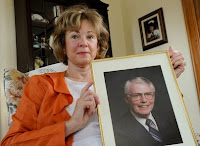

Monique David gave a profound presentation to the Dying with Dignity committee in Quebec. The national post published an special article by her that represents a synopsis of her presentation to the Quebec committee. The article was titled:
Suffering and Strength. Please read:
Monique David, Special To The National Post · Friday, Sept. 10, 2010
This week, the Select Committee on Dying with Dignity, mandated by Quebec's National Assembly to examine end-of-life issues, began its public hearings. What follows is an abbreviated version of Monique David's testimony to the committee.
On July 14, 2009, my father, having enjoyed reasonable health thus far in his life, suffered a heart attack at the age of 86. He remained significantly weakened, and his quality of life was noticeably diminished. Throughout the following six to seven months, he often expressed a desire to die. My once-optimistic father was experiencing what the Canadian Association of Palliative Care describes as the four main reasons patients want to die: pain and physical suffering; loss of control over their illness, their lives and their bodies; the desire to not be a burden; and depression and psychological distress linked to their illness.
His family doctor prescribed anti-depressants. Thankfully, his anxiety crises mostly disappeared, as did his discourse surrounding death and his perception of burdening the lives of those around him. My family helped him understand that serving his needs was our way to reciprocate for all that he had generously given us throughout his life.
Gradually, he came to realize that he could continue to be useful -- less physically, but more interpersonally. His presence, his listening, his smile and his attentive gaze continue to positively transform those around him. But if we had succumbed to his dark, recurring desires, supported by a doctor or a medical system that legalizes euthanasia, my father would no longer be among us.
This personal experience convinced me that desires to die should be disarmed, not encouraged.
"I want to die" is a powerful sentence whose meaning begs to be questioned and understood -- so we, as a society, can allocate more collective will, expertise, creativity and research, especially for the psychological and physical relief of degenerative diseases.
We urgently need more doctors trained in pain management, which should become an essential part of basic university medical training. Regarding psychological, social and spiritual suffering, palliative care medicine is a highly effective solution. This multidisciplinary expertise addresses all dimensions of the person; additionally, it is inexpensive.
We live in a society that places much undue importance on the body and its appearance. Illness rattles this mirage. Exposure to suffering opens a door, unseen until then, on the internal richness of the human being and its spiritual dimension.
Compassion for those going through this process requires us to suffer with the patient, and implies an acceptance of his suffering in our lives without adopting a defeatist or passive attitude. Compassion is to do all that we can to eliminate the pain within the individual and not seek to kill the individual to eliminate the pain. A society that strives to be compassionate must support the sufferer and his support network, must continuously find or develop means of assistance and relief, encourage volunteering, promote family solidarity and sustain disabled people.
Euthanasia and assisted suicide advocates claim the right to terminate life at the moment and in the way that the individual chooses (or that someone chooses for his). Therefore, we should not be referring to the "right to die" (a right that is intrinsic to the human condition), but rather to the right to be killed. It is separate from suicide, which has existed since the dawn of humanity, and whose practitioners seek no sanction from society.
The desire for the right to euthanasia and assisted suicide, expressed in the language of human rights, demands the intervention of a third party and a legal system that authorizes it. It implies that doctors become agents of death and that society legally recognizes a crime to be a lawful medical act.
A society that justifies euthanasia and assisted suicide unites around a culture of death, fear and anguish. Conversely, accompanying a person imprisoned by a degenerative disease or at the terminal stage of life demands courage, and an expansion of self. It provides occasion for one to place his life at the service of the other who is slowly losing his.
Monique David is a Montreal-based writer.
Link to the article in the National Post:
http://www.nationalpost.com/todays-paper/Suffering+strength/3504147/story.html




































